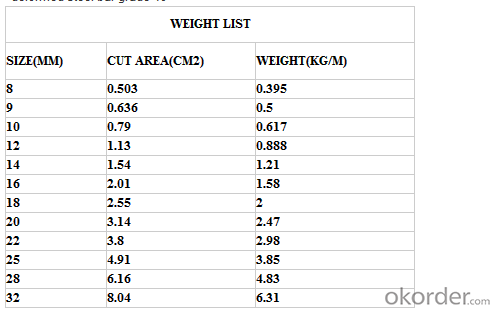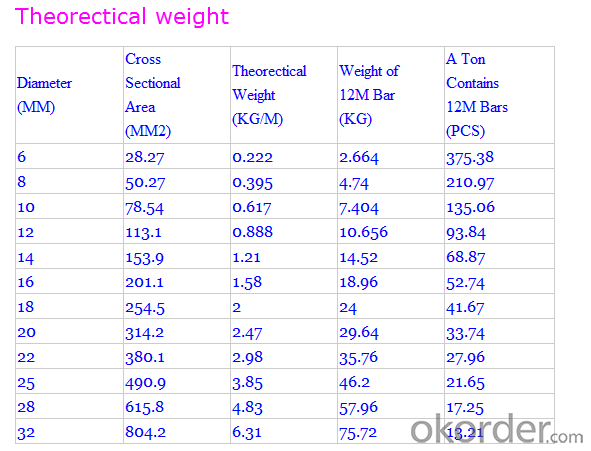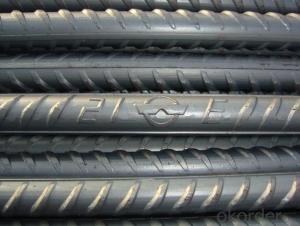Steel Rebar, Deformed Steel Bar, Iron Rods For Construction
- Loading Port:
- Shanghai
- Payment Terms:
- TT OR LC
- Min Order Qty:
- 100 m.t.
- Supply Capability:
- 1000 m.t./month
OKorder Service Pledge
OKorder Financial Service
You Might Also Like
deformed steel bar grade 40
material: HRB400, BS4449 GR460B
size: 8-36mmx12m.
short delivery time by bulk or container
deformed steel bar grade 40
material: HRB400, BS4449 GR460B
size: 8-36mmx12m.
short delivery time with bulk or container
packing: Mill standard export packing in bundles/coil, around 2tons/bundle.
country of Origin: China
delivery Time: Within a 35 days
Shipment: by bulk vessel or by container

Leading goods:
section steel:angles,channels,I-beam,H-beam;
coils:cold/hot rolled coils,PPGI,galvanized coils,plate,checkered plate,cutting steel plate,steel strip;
wire rod:steel wire,deformed wire,bar;
pipe:seamless pipe,rectangular pipe,welded pipe,spiral welded pipe,pipe fittings;
stainless steel:steel sheets,stainless steel strips,stainless bar,stainless tube;
special:weathering steel,shipbuilding steel;
construction steel:C-channel,Z-channel,T-bar,high-speed divider plate,corrugated steel plate,steel grating.
Advantage:
We are the spot supplier, Six huge warehouses which can hold 20,000 MT goods.
It makes the cost lower than others,we can provide the competitive price for you.
Delivery time:
Normal sizes can be provided in 7days, the others should be ready in 30---45 days.
Further treatment:
We can offer cutting,painting,drilling holes,bending,threading, welding,galvanization,packing etc.
Security interest:
We have already passed the ISO9001, BV and SGS authentication which makes the quality secured.
If you have the interest in any of the products we can provided, pls don't hesitate to connect with me. Looking forward to cooperate with you.

FAQ of Steel Deformed Bar
1. More than 10 years experience in this industry
2. 100,000 tons exporting per month
3. Professional foreign trade tea
4. OEM&ODM capacity
5. High quality assured & competitive price
6. Try our best to meet your needs & save your budget
7. Very popular in Southeast Asia, Africa, Mid-East and South America etc.
8. VIP membership system, first time customers and long-term cooperation customers can get extra discount on some products.
- Q:Are there any limitations on using steel rebars in cold climates?
- Using steel rebars in cold climates comes with certain limitations. The primary concern is the possibility of corrosion caused by moisture, salt, and de-icing chemicals commonly applied to roads and bridges during winter. Exposure to these elements can lead to rusting and gradual weakening of steel rebars, compromising the concrete's structural integrity. To address this issue, there are several measures that can be taken. One common approach is the use of epoxy-coated rebars, which offer protection against moisture and chemicals. Another option is to utilize stainless steel rebars, as they have high resistance to corrosion. However, it is worth noting that these alternatives can be more expensive compared to traditional steel rebars. Additionally, the construction process in cold climates presents its own set of challenges. Low temperatures result in slower curing and strengthening of concrete, which can affect the overall project timeline. To ensure proper curing, special precautions such as heating the concrete or using accelerators may be necessary. To guarantee compliance and safety, it is crucial to consult local building codes and regulations that are specific to cold climates. Seeking guidance from engineering professionals experienced in cold weather construction practices can provide valuable insights and recommendations to address the limitations associated with using steel rebars in these conditions.
- Q:Why is thread steel thinner than crude?
- Reduce the quality of the project, and the use of low carbon steel instead of rebar. For large engineering projects, often appear to "project inspector", to replace the steel rib steel "Choulianghuanzhu", reduce the construction cost. In the design, because the members allowed to provide "stirrup stress support", the main role is to keep the shape and location of longitudinal reinforcement, steel strapping has a smooth surface, accurate positioning, therefore, in addition to longitudinal reinforcement, licensing round steel stirrups. The longitudinal reinforcement must be made of rib steel.
- Q:What is the process of anchoring steel rebars in concrete?
- The process of anchoring steel rebars in concrete involves several steps. First, the rebars are cut to the required length and bent as per the structural design. Next, the concrete formwork is prepared, ensuring it is clean and free from any debris. Once the formwork is ready, the rebars are carefully placed and positioned within the formwork according to the specified spacing and alignment. They are usually supported by chairs or spacers to maintain the desired position. After the rebars are properly positioned, the formwork is secured, and concrete is poured, ensuring it completely surrounds and covers the rebars. The concrete is then allowed to cure and harden, providing a strong bond between the steel rebars and the concrete. Ultimately, the process of anchoring steel rebars in concrete involves proper planning, positioning, and securing of the rebars within the formwork, followed by pouring and curing of the concrete to create a robust and durable structure.
- Q:What are the design considerations for using steel rebars in construction?
- Some important design considerations for using steel rebars in construction include the required strength and load-bearing capacity, corrosion resistance, compatibility with other construction materials, durability, and ease of installation. Steel rebars should be chosen based on their appropriate diameter, grade, and spacing to ensure structural integrity and safety. Additionally, proper detailing and placement of rebars are essential to ensure that they are effectively embedded within concrete and can withstand the anticipated stresses and forces during construction and throughout the lifespan of the structure.
- Q:What is the process of installing steel rebars in concrete?
- The process of installing steel rebars in concrete involves several steps. First, the concrete surface is prepared by cleaning it from any debris or loose particles. Then, the rebars are cut, shaped, and positioned according to the structural requirements using supports or chairs to maintain proper spacing and elevation. Next, the rebars are securely tied together at the intersections using wire or mechanical connectors. After that, the rebars are placed within the concrete forms, ensuring they are adequately centered and do not touch the sides or bottom. Finally, the concrete is poured, encapsulating the rebars, and left to cure, creating a strong bond between the steel and concrete for enhanced structural integrity.
- Q:Can steel rebars be used in the construction of residential towers?
- Yes, steel rebars can be used in the construction of residential towers. Steel rebars provide strength and durability to reinforced concrete structures, making them an ideal choice for high-rise buildings like residential towers. They help reinforce the concrete and enhance its load-bearing capacity, ensuring the structural integrity and safety of the construction.
- Q:What is the impact of steel rebars on the constructability of a project?
- Steel rebars have a significant impact on the constructability of a project. They provide strength and stability to reinforced concrete structures, enhancing their durability and load-bearing capacity. By reinforcing concrete, steel rebars enable the construction of taller and more complex structures. Additionally, rebars also facilitate efficient construction processes, such as faster concrete pouring and reduced formwork requirements. Overall, the presence of steel rebars greatly improves the constructability and long-term performance of a project.
- Q:Can steel rebars be used in road and bridge construction?
- Steel rebars are indeed suitable for use in road and bridge construction. They are widely employed as reinforcement in concrete structures, such as roads and bridges, to bolster their strength and endurance. These rebars are embedded within the concrete, serving to enhance its tensile strength and prevent any cracking or structural failure. The choice of steel rebars for such constructions is driven by their remarkable attributes, including high strength, ductility, and resistance to corrosion. By evenly distributing loads and stresses, they impart greater resilience to the structures, enabling them to withstand heavy traffic and various environmental conditions. Moreover, steel rebars can be easily fabricated and tailored to meet the precise design requirements of road and bridge construction projects.
- Q:What are the advantages of using epoxy-coated stainless steel rebars?
- There are several advantages of using epoxy-coated stainless steel rebars. Firstly, the epoxy coating provides an additional layer of protection to the stainless steel rebars, thereby enhancing their corrosion resistance. Stainless steel already possesses good corrosion resistance properties, but the epoxy coating acts as a barrier against moisture, chemicals, and other corrosive elements that may come in contact with the rebars. This helps to extend the service life of the rebars and ensures the long-term durability of the structure. Secondly, epoxy-coated stainless steel rebars offer improved bond strength with concrete. The epoxy coating creates a rough surface texture, which enhances the adhesion between the rebar and the concrete. This results in a stronger bond, increasing the overall structural integrity of the reinforced concrete. Another advantage is the ease of handling and installation. The epoxy coating provides a smooth surface, making it easier to handle and position the rebars during construction. Additionally, the coating reduces the risk of injury to workers as it eliminates the sharp edges that are typically associated with bare steel rebars. Furthermore, epoxy-coated stainless steel rebars are environmentally friendly. The epoxy coating is free from harmful substances such as lead and other heavy metals, which may be present in alternative coating materials. This makes them a sustainable choice, especially in projects that prioritize environmental considerations. Lastly, epoxy-coated stainless steel rebars require minimal maintenance. The epoxy coating provides a protective layer that reduces the need for frequent inspections and repairs. This not only saves time and costs but also minimizes disruptions to ongoing construction projects. In summary, the advantages of using epoxy-coated stainless steel rebars include enhanced corrosion resistance, improved bond strength, ease of handling and installation, environmental friendliness, and reduced maintenance requirements. These benefits make epoxy-coated stainless steel rebars a reliable and cost-effective choice for reinforcing concrete structures.
- Q:Can steel rebars be used in structures exposed to extreme temperatures?
- Yes, steel rebars can be used in structures exposed to extreme temperatures. Steel has high thermal conductivity, which allows it to transfer heat quickly, minimizing the risk of structural damage due to thermal expansion or contraction. However, it is essential to consider the specific temperature range and the potential impact on the structural integrity of the rebar. In extremely high temperatures, other materials or protective measures may be necessary to ensure the stability and safety of the structure.
1. Manufacturer Overview |
|
|---|---|
| Location | |
| Year Established | |
| Annual Output Value | |
| Main Markets | |
| Company Certifications | |
2. Manufacturer Certificates |
|
|---|---|
| a) Certification Name | |
| Range | |
| Reference | |
| Validity Period | |
3. Manufacturer Capability |
|
|---|---|
| a)Trade Capacity | |
| Nearest Port | |
| Export Percentage | |
| No.of Employees in Trade Department | |
| Language Spoken: | |
| b)Factory Information | |
| Factory Size: | |
| No. of Production Lines | |
| Contract Manufacturing | |
| Product Price Range | |
Send your message to us
Steel Rebar, Deformed Steel Bar, Iron Rods For Construction
- Loading Port:
- Shanghai
- Payment Terms:
- TT OR LC
- Min Order Qty:
- 100 m.t.
- Supply Capability:
- 1000 m.t./month
OKorder Service Pledge
OKorder Financial Service
Similar products
New products
Hot products
Related keywords





























